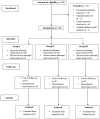Evaluation of analgesic efficacy of dexmedetomidine as adjuvant with ropivacaine in ultrasound-guided adductor canal block in patients following anterior cruciate ligament reconstruction surgeries
- PMID: 31019690
- PMCID: PMC6463348
- DOI: 10.1177/2049463718796865
Evaluation of analgesic efficacy of dexmedetomidine as adjuvant with ropivacaine in ultrasound-guided adductor canal block in patients following anterior cruciate ligament reconstruction surgeries
Abstract
Introduction: Local anaesthetic (LA) with highly selective alpha-2 agonist dexmedetomidine has not been evaluated in adductor canal block (ACB) for arthroscopic anterior cruciate ligament (ACL) reconstruction surgeries. The study evaluates postoperative analgesic effect of ropivacaine with adjuvant dexmedetomidine following postoperative ultrasound-guided ACB.
Methods: 105 randomized subjects received ultrasound-guided ACB using 15 mL of 0.5% ropivacaine, with 0.5 µg kg-1 of dexmedetomidine administered perineurally (Group II), intravenously (Group III) or none (Group I). Primary outcome included 24 hours' total morphine consumption postoperatively. Secondary outcomes included haemodynamics and adverse effects.
Results: The postoperative total morphine consumption was significantly reduced till 4 hours in II 0.57 mg (0.98 (0-3)) (p = 0.011) and up to 6 hours in Group III 0.77 mg (1.00 (0-4)) (p = 0.004) compared to Group I. The postoperative total morphine consumption was comparable at 24 hours in Group III 3.57 mg (1.73 (0-8)) and Group II 3.34 mg (1.92 (07)) (p = 1.000). The visual analogue scale (VAS) scores were comparable in all the three groups at all the time intervals studied (p > 0.05). There were no adverse effects observed during the study.
Conclusion: Use of perineural dexmedetomidine with LA for ACB in the postoperative period resulted in significant reduction in total morphine consumption in initial 4 hours as compared to 6 hours with intravenous (IV) dexmedetomidine.
Keywords: Anterior cruciate ligament; dexmedetomidine; postoperative analgesia; saphenous nerve block.
Conflict of interest statement
Conflict of interest: The author(s) declared no potential conflicts of interest with respect to the research, authorship and/or publication of this article.
Figures





Similar articles
-
Role of dexmedetomidine as adjuvant in postoperative sciatic popliteal and adductor canal analgesia in trauma patients: a randomized controlled trial.Korean J Pain. 2020 Apr 1;33(2):166-175. doi: 10.3344/kjp.2020.33.2.166. Korean J Pain. 2020. PMID: 32235017 Free PMC article.
-
Comparative Study of Adductor Canal Block and Femoral Nerve Block for Postoperative Analgesia After Arthroscopic Anterior Cruciate Ligament Tear Repair Surgeries.Cureus. 2022 Apr 10;14(4):e24007. doi: 10.7759/cureus.24007. eCollection 2022 Apr. Cureus. 2022. PMID: 35547414 Free PMC article.
-
Adductor canal block versus local infiltration analgesia for postoperative pain after anterior cruciate ligament reconstruction: a single centre randomised controlled triple-blinded trial.Br J Anaesth. 2019 Aug;123(2):e343-e349. doi: 10.1016/j.bja.2019.04.053. Epub 2019 May 24. Br J Anaesth. 2019. PMID: 31130273 Free PMC article. Clinical Trial.
-
Evidence Basis for Regional Anesthesia in Ambulatory Arthroscopic Knee Surgery and Anterior Cruciate Ligament Reconstruction: Part II: Adductor Canal Nerve Block-A Systematic Review and Meta-analysis.Anesth Analg. 2019 Feb;128(2):223-238. doi: 10.1213/ANE.0000000000002570. Anesth Analg. 2019. PMID: 29064877
-
Effect of Adductor Canal Block Versus Femoral Nerve Block on Quadriceps Strength, Function, and Postoperative Pain After Anterior Cruciate Ligament Reconstruction: A Systematic Review of Level 1 Studies.Am J Sports Med. 2020 Jul;48(9):2305-2313. doi: 10.1177/0363546519883589. Epub 2019 Dec 4. Am J Sports Med. 2020. PMID: 31800300
Cited by
-
Motor-Sparing Effect of Adductor Canal Block for Knee Analgesia: An Updated Review and a Subgroup Analysis of Randomized Controlled Trials Based on a Corrected Classification System.Healthcare (Basel). 2023 Jan 10;11(2):210. doi: 10.3390/healthcare11020210. Healthcare (Basel). 2023. PMID: 36673579 Free PMC article.
-
Role of dexmedetomidine as adjuvant in postoperative sciatic popliteal and adductor canal analgesia in trauma patients: a randomized controlled trial.Korean J Pain. 2020 Apr 1;33(2):166-175. doi: 10.3344/kjp.2020.33.2.166. Korean J Pain. 2020. PMID: 32235017 Free PMC article.
-
Peripheral Nerve Blockade for Medial Patellofemoral Ligament Reconstruction in Pediatric Patients: The Addition of a Proximal Single-Injection Sciatic Nerve Block Provides Improved Analgesia.Local Reg Anesth. 2022 Jun 27;15:31-43. doi: 10.2147/LRA.S360738. eCollection 2022. Local Reg Anesth. 2022. PMID: 35782524 Free PMC article.
-
Effects of adductor canal block versus femoral nerve block in patients with anterior cruciate ligament reconstruction: A protocol for a systematic review and meta-analysis.Medicine (Baltimore). 2019 Sep;98(36):e16763. doi: 10.1097/MD.0000000000016763. Medicine (Baltimore). 2019. PMID: 31490364 Free PMC article.
-
Dexmedetomidine as an Adjuvant in Peripheral Nerve Block.Drug Des Devel Ther. 2023 May 17;17:1463-1484. doi: 10.2147/DDDT.S405294. eCollection 2023. Drug Des Devel Ther. 2023. PMID: 37220544 Free PMC article. Review.
References
-
- Thapa D, Ahuja V, Verma P, et al. Post-operative analgesia using intermittent vs. continuous adductor canal block technique: a randomized controlled trial. Acta Anaesthesiol Scand 2016; 60: 1379–1385. - PubMed
-
- Parker RD, Streem K, Schmitz L, et al. Efficacy of continuous intra-articular bupivacaine infusion for postoperative analgesia after anterior cruciate ligament reconstruction: a double-blinded, placebo-controlled, prospective, and randomized study. Am J Sports Med 2007; 35: 531–536. - PubMed
-
- Venn RM, Bradshaw CJ, Spencer R, et al. Preliminary UK experience of dexmedetomidine, a novel agent for postoperative sedation in the intensive care unit. Anaesthesia 1999; 54: 1136–1142. - PubMed
-
- Abdallah FW, Brull R. Facilitatory effects of perineural dexmedetomidine on neuraxial and peripheral nerve block: a systematic review and meta-analysis. Br J Anaesth 2013; 110: 915–925. - PubMed
LinkOut - more resources
Full Text Sources
